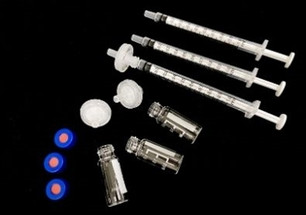Posted by Chrom Tech on 15th Oct 2025
Essential List of Chromatography Supplies

Chromatography is a fundamental analytical technique used to separate, identify, and quantify components within complex mixtures. It’s widely employed across research, pharmaceutical, and clinical laboratories, with two of the most common methods being gas chromatography (GC) and high-performance liquid chromatography (HPLC). To achieve reliable results, laboratories rely on a range of specialized consumables and replacement parts.
Below is an essential list of chromatography supplies available from Chrom Tech—your trusted source for chromatography consumables, instruments, and accessories.
Vials and Closures
Chromatography vials and closures are essential for sample collection, storage, and injection. Glass vials are preferred for their inertness, while plastic vials are ideal for specific automated workflows. Selecting the correct vial type ensures compatibility with autosamplers and reduces contamination risk.
- Crimp-top vials – Best for volatile samples and secure sealing.
- Screw-top vials – Convenient and easy to handle for non-volatile samples.
- Amber or black vials – Protect light-sensitive compounds.
Closures include both caps and septa. Choose chemically inert materials to prevent interaction with the analyte and to maintain sample integrity. Push-on or screw caps are suitable for general use, while crimp caps provide a tighter seal for volatile samples.
Sample Preparation Consumables
Sample preparation ensures clean, interference-free injections that protect the column and prolong instrument life. Common consumables include syringe filters and solid-phase extraction (SPE) products.
Syringe Filters
Syringe filters remove particulates from liquid samples prior to analysis. They are widely used in HPLC, LCMS, and ion chromatography workflows. The key selection criteria include:
- Membrane type: Choose based on solvent and analyte compatibility (e.g., PTFE, PVDF, Nylon).
- Porosity: Common pore sizes are 0.2 µm and 0.45 µm, depending on the particulate size.
- Diameter: Match the filter diameter to your sample volume for optimal flow and efficiency.
Solid-Phase Extraction (SPE)
SPE is used to clean and concentrate samples before injection. The technique involves conditioning the cartridge, loading the sample, washing impurities, and eluting the analytes of interest.
Chrom Tech offers Agilent Bond Elut SPE products, including C18 cartridges—ideal for retaining nonpolar organic analytes from aqueous matrices. Bond Elut C18 is the most popular hydrophobic bonded silica sorbent due to its high retention and reproducibility across a wide range of compounds.
Tubing and Fittings
Reliable tubing and fittings are critical to maintaining consistent flow, pressure stability, and chromatographic integrity. Each connection must be properly designed for the pressure and solvent compatibility of your system.
- FEP and PFA tubing: Excellent chemical resistance, ideal for solvent lines under low pressure.
- PEEK and stainless-steel tubing: Withstand higher pressures; suitable for post-pump connections.
Chrom Tech’s pre-cut stainless steel tubing is electrolytically cut for burr-free ends and optimal sealing—reducing leaks and dead volume in high-pressure systems.
Columns
Chromatography columns are the heart of every system, responsible for the separation of analytes based on polarity, size, and interaction with the stationary phase. Column performance depends on both chemistry and physical dimensions.
Columns are typically constructed from stainless steel or PEEK and packed with silica or polymer-based stationary phases. Choosing the correct dimensions ensures optimal balance between sensitivity, resolution, and sample loading capacity. Smaller internal diameters offer higher sensitivity, while larger columns allow greater throughput.
Instrumentation Replacement Parts
Maintaining instrument uptime requires readily available replacement parts. Chrom Tech supplies OEM and OEM-equivalent parts for major brands including Agilent, Shimadzu, Thermo, and Waters.
LC Replacement Parts
Replacement components include pump pistons, seals, check valves, and detector lamps—compatible with leading LC systems.
GC Replacement Parts
For GC instrumentation, Chrom Tech offers inlet liners, septa, FID jets, seals, and mass spectrometer electron multipliers to keep your systems performing optimally.
Syringes
Chromatography syringes are essential for sample introduction, whether manual or automated. They are available in various capacities and configurations to suit both GC and LC systems. A quality syringe provides accurate delivery with minimal dead volume and must resist chemical corrosion from solvents and samples.
Solvents and Reagents
LC Solvents
HPLC-grade solvents (or better) are essential for accurate, reproducible separations. For UHPLC and LCMS systems, use LCMS-grade solvents to minimize background noise and ion suppression. Maintaining the correct pH—typically between 2 and 8—improves retention, reproducibility, and selectivity.
GC Reagents
GC derivatization reagents enhance the volatility, detectability, and stability of analytes. Common derivatization techniques include silylation, acylation, and alkylation. Chrom Tech offers high-purity reagents from Regis Technologies to ensure reliable, reproducible GC analysis.
Summary
Every step of chromatography—from sample preparation to detection—depends on using the right consumables. By sourcing vials, filters, columns, fittings, and solvents from Chrom Tech, you ensure your laboratory achieves consistent, precise, and reproducible results.
Contact Chrom Tech’s technical team for expert guidance on selecting chromatography supplies tailored to your applications.
Frequently Asked Questions About Chromatography Supplies
What are the essential supplies for running HPLC or GC analyses?
Essential chromatography supplies include vials and closures, filters, columns, tubing, syringes, solvents, and replacement instrument parts. Each plays a crucial role in maintaining accuracy and system integrity.
How do I choose the right syringe filter for my application?
Select your syringe filter based on solvent compatibility, membrane type, pore size, and sample volume. Chrom Tech provides a full range of filters suitable for HPLC and LCMS workflows.
What solvent grades should I use for HPLC and LCMS?
Use HPLC-grade solvents for standard liquid chromatography and LCMS-grade solvents for UHPLC and mass spectrometry to ensure low background noise and reproducible performance.

